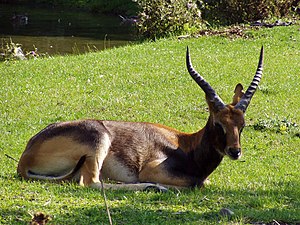White-naped bog antelope
| White-naped bog antelope | ||||||||||||
|---|---|---|---|---|---|---|---|---|---|---|---|---|

White-naped bog antelope |
||||||||||||
| Systematics | ||||||||||||
|
||||||||||||
| Scientific name | ||||||||||||
| Kobus megaceros | ||||||||||||
| ( Fitzinger , 1855) |
The white-naped bog antelope ( Kobus megaceros ), also Mrs. Gray's waterbuck , is an African antelope belonging to the genus of waterbuck . The species lives exclusively in the Nile marshes, 3,000 kilometers north of the Lechwe, which is closely related to it and occurs in the humid savannas of Central Africa.
External features
The white-naped bog antelope is a strong swamp antelope with a long coat, a shoulder height of 80 to 105 centimeters, a length of 135 to 165 centimeters and a weight of 60 to 120 kilograms.
Like the brown-red Lechwe , she has a fairly short face. The hooves are exceptionally long, with the inner toe much narrower than the outer. The bucks have lyre-like, S-shaped curved horns, but thinner, longer and steeper than other bog antelopes that are 50 to 85 centimeters long. The goats' fur slowly darkens over the years until they reach a black like dark chocolate. The mahogany-colored bucks have a fist-sized, pure white spot behind the horns, from which a white stripe runs down the neck, which becomes a wide white saddle at the front part of the withers . The underside and tail are creamy white. The hornless females are yellowish to brown-red in color, much lighter than the bucks, with weakened markings.
distribution
The distribution area is limited to the Sudd region in South Sudan near Malakal . The alluvial plain there is traversed by the White Nile, which, with its constantly changing tributaries, forms a widely ramified swamp area. The white-naped bog antelope lives in large groups of fifty or more individuals, but does not form as large packs as the Letschwe.
behavior
Depending on the water level of the river and the floodplains in the rainy season, the antelope follows the changing edge of the swamp area. They move away from the river and upstream, 30 to 40 km depending on the water level, to their respective grazing grounds. They feed almost exclusively on marsh grasses and live in mixed packs of 50 or more animals.
Danger
Up to 1980 there were still around 36,000 animals, half of which were distributed between the two banks of the Nile. In the meantime, their population has declined sharply, so a census from the air in 2007 could only count 4291 individuals in South Sudan, mainly in the vicinity of the Zerat nature reserve. The IUCN lists the status of the white-naped bog antelope as endangered .
literature
- CA Spinage: The Natural History of Antelopes . Croom Helm, London 1986, ISBN 0-7099-4441-1
- Kingdon, Jonathan: The Kingdon Field Guide To African Mammals, ISBN 0-7136-6513-0 ;
- Grzimeks Tierleben, Volume 13: Mammals 4
Web links
- Kobus megaceros in the endangered Red List species the IUCN 2008. Posted by: Antelope Specialist Group, 2008. Accessed January 2 of 2009.
Single receipts
- ↑ Spinage, pp. 180-181
